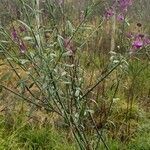Perennial somewhat-branched shrub up to 2 m high. Young stems with short curly hairs, glabrous when older. Lvs all alternate, glabrous or sparsely hairy, oblanceolate, obovate or linear, obtuse to acute, mucronate, entire, subsessile, 10-40 mm long. Fls in loose, branched or simple, terminal racemes; perianth coloured pink to purple toward apex; pedicels 5-10 mm long; bracts ovate-triangular, c. 2 mm long, deciduous; 3 outer sepals elliptic to obovate, 4-5 mm long; wings petaloid, c. 10-12 mm long, ± = or > corolla; outer petals entire, c. 1/2 length of keel; keel fimbriate at apex. Capsule glabrous, c. 6-10 mm long with a marginal wing c. 1 mm wide, 1/2-⅔ length of persistent calyx wings; seeds hairy, narrow-oblong, c. 4-5 mm long; strophiole 3-lobed.
Perennial, dwarf shrub. Stems sparsely foliose or densely pubescent, rarely glabrous, 1.5-3.0 m high. Leaves linear or obovate-linear (2-20 mm wide). Flowers in terminal racemes on ultimate branchlets, papilionaceous; bracts and bracteoles 2-3 mm long. Flowering time Oct.-Feb. Fruit a laterally flattened capsule, with acute or narrowly winged margins, which open along top and bottom and expose a hairy seed in each locule. Seed: caruncle asymmetric, with odd branch less than double the length of others, silky short hairs never exceeding base of seed for > 1 mm long.
Slender-stemmed shrub, sometimes to 2 m, stems only leafy above. Leaves mostly lanceolate-elliptic. Flowers many in terminal racemes, uniformly dark purple, side petals entire, pedicels hairy.

